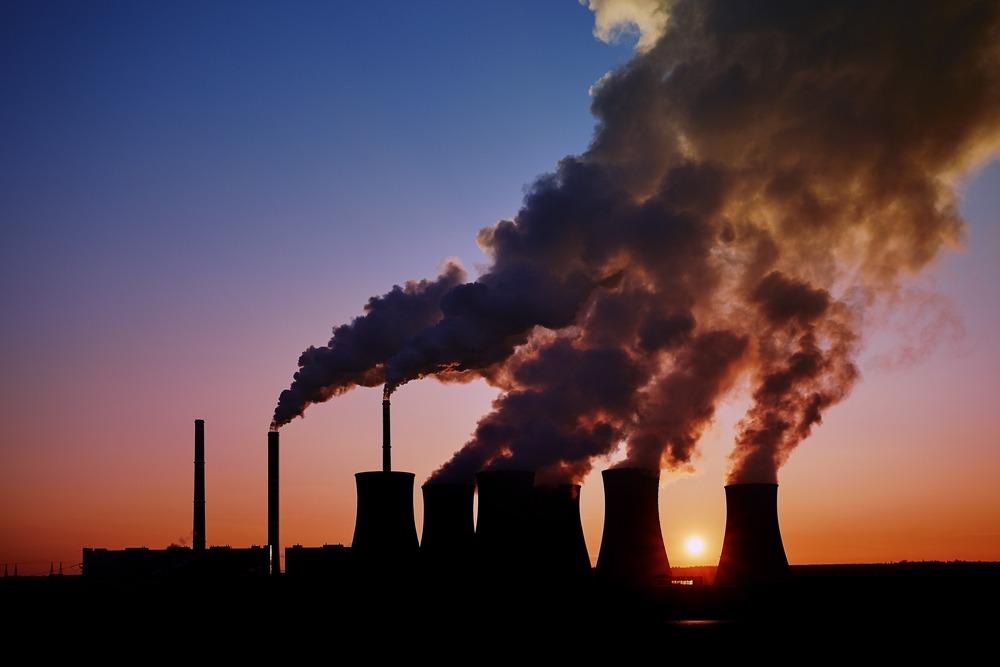Quick and efficient conversion of atmospheric CO2 into chemical feedstock is one of the most promising approaches to mitigate anthropogenic CO2 emissions, a primary driver of climate change. Recently, researchers from the University of Tsukuba in Japan created a polymer coating that, when applied to a standard metal catalyst, dramatically accelerates the electrochemical CO2 conversion.

Image Credit: kamilpetran/Shutterstock.com
Mainly due to the extensive use of fossil fuels, CO2 concentrations in the atmosphere have risen from 280 parts per million (ppm) in the pre-industrial era to today's 410 ppm. With the ever-increasing share of polymer materials in the modern economy, addressing CO2 emissions associated with plastic production has become a strategic focal point.
CO2 Conversion into Value-Added Chemicals
Life-cycle analyses of fossil-based feedstocks for the petrochemical and chemical industries, such as ethylene, propylene, and others, show that their production emits approximately 0.4–1.2 kg of CO2 per kg of feedstock produced by petrochemical cracking processes. Data like this has urged scientists to explore new carbon capture methods that can convert atmospheric CO2 into chemicals traditionally sourced from oil or natural gas. Such a scheme, together with the use of recyclable feedstock, has the potential to circularize the polymer production chain.
Besides, electrochemical carbon capture offers an attractive opportunity to store renewable energy in a chemical form by producing carbon-based fuels and chemical feedstock from CO2. The electrochemical reduction of CO2 is a complex conversion process comprising multiple proton-electron reaction steps, ultimately generating products with high commercial value, like ethylene, methane, or formic acid.
What Are the Limitations for Electrochemical Carbon Capture?
In the traditional fuel cell-based electrochemical reactor designs, electrodes are separated by a polymer membrane. Due to the low specific surface area, these designs possess intrinsic mass transfer limitations between gas-liquid-solid phases, limiting the overall conversion efficiency. To overcome these issues and enable highly efficient electrochemical CO2 conversion, researchers have focused their attention on the development of porous gas diffusion metal electrocatalysts.
As one of the most critical components in a CO2 conversion system, the gas diffusion catalytic electrodes have been the subject of intensive research in previous years. One of the most promising avenues to explore is enhancing the CO2 selectivity of the catalyst/electrode assembly. The use of CO2 adsorbing materials as an electrode coating proved a promising approach to improve the selectivity of CO2 conversion. Unfortunately, the design and synthesis of dedicated compounds with high selectivity and permeability for CO2 are complex and expensive.
Polymer Coatings Accelerate Electrocatalysis
Recently, a research group led by Dr. Yoshikazu Ito, an associate professor at the University of Tsukuba, demonstrated how an inexpensive polymer coating applied to a porous tin (Sn) electrocatalyst can increase CO2 conversion efficiency several-fold. Their research was published in the journal ACS Catalysts on July 26th, 2021.
Some polymers like polyethyleneimine (PEI) and polyethylene glycol (PEG) can effectively capture CO2 molecules. The idea of Dr. Ito's team was that such CO2-absorbing polymers could effectively increase the number of CO2 molecules reaching the catalyst surface and create a CO2-rich local environment. The result will be an accelerated catalytic reaction on the catalyst's surface.
The scientists developed an original deposition method that enabled them to create a special conformal PEG (a low-cost and abundant polymer with a wide range of applications) coating on a porous tin electrode without affecting the porosity of the electrocatalyst. The thickness of the polymer layers was optimized in a series of detailed investigations while monitoring the performance of the polymer-coated metal catalyst.
Optimized Polymer-Coated Metal Catalyst for Future Clean Technology Applications
Conventionally, tin-based catalysts are used to convert CO2 to formic acid or formate (HCOO−). The experiments of Dr. Ito's colleagues demonstrated that the PEG-coated electrocatalyst could produce 1.5 times more formate compared to a similar non-coated porous electrode. Compared to a conventional tin plate electrode, the formate production rate was 24 times higher, with no byproducts present (with 99% formate yield).
Next, the scientist devised a series of experiments to understand how the CO2 molecules are transferred through the polymer coating and delivered to the catalytically active site. They have compared the CO2 conversion rates of the PEG-coated catalyst and the same catalyst coated with another CO2-capturing polymer (PEI), which has a stronger affinity to CO2. The PEG-coating still outperformed the PEI-coating in terms of CO2 conversion efficiency.
Further theoretical modeling revealed that PEI-coating held the CO2 molecules too tightly, whereas PEG-coating provided the right balance between capture, transport, and release at the electrocatalyst surface. Another critical factor in that balance was the morphology of the polymer coating itself. The PEG-coating was too dense and thick, which also had a detrimental effect on CO2 conversion.
According to the team, the newly-developed polymer coating can be employed to improve the existing electrosynthesis processes where an initial CO2 adsorption step drives further electrochemical reactions. Such developments enable the production of many other valuable chemicals, such as methane, methanol, ethane, ethanol, and olefins, from atmospheric CO2.
References and Further Reading
Jeong, S., et al., (2021) Polyethylene Glycol Covered Sn Catalysts Accelerate the Formation Rate of Formate by Carbon Dioxide Reduction. ACS Catalysis 11 (15), 9962-9969. Available at: https://doi.org/10.1021/acscatal.1c02646 [Accessed on September 1st 2021].
University of Tsukuba (2021) Polymer coating accelerates fuel production [Online] Science Daily. Available at: https://www.sciencedaily.com/releases/2021/08/210805133758.htm [Accessed on September 1st 2021].
Adamu, A., et al., (2020) Process intensification technologies for CO2 capture and conversion – a review. BMC Chem. Eng. 2, 2. Available at: https://doi.org/10.1186/s42480-019-0026-4 [Accessed on September 1st 2021].
Pappijin, C. A. R, et al., (2020) Challenges and Opportunities of Carbon Capture and Utilization: Electrochemical Conversion of CO2 to Ethylene. Front. Energy Res. Available at: https://www.frontiersin.org/articles/10.3389/fenrg.2020.557466/full [Accessed on September 1st 2021].
Disclaimer: The views expressed here are those of the author expressed in their private capacity and do not necessarily represent the views of AZoM.com Limited T/A AZoNetwork the owner and operator of this website. This disclaimer forms part of the Terms and conditions of use of this website.